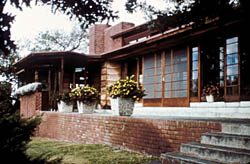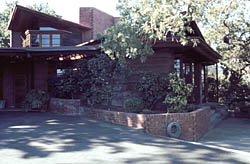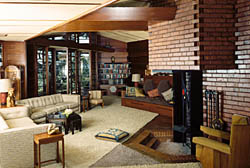 Palo Alto Stanford Heritage
Palo Alto Stanford Heritage  |
 |
 |
National Historic Landmarks photos |
The Hanna–Honeycomb house was Frank Lloyd Wright’s (1867–1959) first work in the San Francisco area. Built in 1936 for Paul Hanna and his wife, Jean, it is listed on the National Register of Historic Places and is considered to be one of 17 Wright buildings most representative of Wright’s contribution to American culture.
Wright was an architect, interior designer, educator and writer who gained fame as a leader of the Prairie School movement of architecture in the early 20th century. During the depression, he developed the concept of the Usonian home in an effort to create a uniquely democratic style that was affordable for the “common people” of the United States. Built on concrete slabs with flat roofs, these houses featured new approaches to construction, including sandwich walls that consisted of layers of wood siding, plywood cores and building paper instead of the typical framed walls. Spatially and in terms of their construction, the Usonian houses represented a new model for independent living emphasizing affordability and spatial flow. Wright envisioned his homes creating a more harmonious, enlightened society.
The Hanna House, begun in 1937 and expanded over 25 years, is a product of these Usonian reformist ideals. It is the first and best example of Wright's innovative hexagonal design. Patterned after the honeycomb of a bee, the house incorporates six–sided figures with 120–degree angles in its plan, its numerous tiled terraces and even in built–in furnishings. The house is one–story high with a central clerestory and is constructed of native redwood board and batten, San Jose brick, cement and plate glass. It has four bedrooms, three bathrooms, a kitchen and a living area—described on the drawings as "sanctum." Also on the property are a guesthouse, hobby shop, garage, carport and extensive landscaping with water features. Wright's system of polygonal modules provides the openness that he associated with freedom of movement while gracefully integrating the house with its sloping topography of its one-half acre site. The Hanna–Honeycomb house with no right angles in the floor plan was a radical experiment which allowed Wright to fully explore open spatial planning. It was a turning point in his career, leading to ideas later evidenced in the Guggenheim Museum in New York.
The construction of the Hanna house is intertwined with the tumultuous academic career of Paul Hanna. It illustrates his dual qualities of supreme self–confidence, boundless energy and, some said, audacity. A graduate of Hamline University, Hanna received his Ph.D. from Columbia University and taught at Teachers College before joining the Stanford faculty in 1935. Paul and his wife Jean, whom he had married in 1926, became enamored of Wright’s philosophy of architecture through his 1931 book, Modern Architecture. A “fan letter” ensued, resulting in an invitation to Wright’s home, Taliesin, where the young couple impetuously asked Wright to design a house for them someday.
Upon accepting Stanford’s offer of an associate professorship in 1935, Hanna and Jean packed their three children and the family dog into the car heading west. Most importantly, they immediately hired Frank Lloyd Wright. University personnel thought it audacious for a junior faculty member to not only choose a world famous architect but also to select a pristine building site on top of Frenchman’s Hill. Weeks of intense lobbying by Hanna ultimately convinced President Ray Lyman Wilbur to acquiesce to ”Hanna’s folly”, but further obstacles soon emerged.
Wright’s innovative honeycomb design had left the Hannas “speechless, curious and electrified.” When construction began in 1937, it left the building crew witless as they wrestled with 120 degree angles, ceilings that slanted like tents and glass walls that folded like screens. A competent foreman was hired once Paul realized he could not be professor, husband, father and general contractor. Nothing could impede the fulfillment of the Hannas’ dream house, not even the fact that part of the property lay on the San Andreas fault. Not a problem, opined Wright, who boasted that the house would withstand an earthquake. Fortunately, the Hannas and Wright did not live to see the havoc wrought by the 1989 Loma Prieta quake. Extensive damage was incurred, not because of its location, but rather because of the original construction techniques. Perhaps the most worrisome issue was that the construction estimate of $15,000 ballooned, in typical Wright fashion, to $37,000. Some original design features were delayed and the Hannas were forced to take out a loan which was arranged through Paul’s publisher, Scott Foresman. Despite obstacles, the Honeycomb house was completed and provided an idyllic family home for the Hanna family. They donated it to Stanford in 1974.
Paul Hanna and Jean, who was his professional collaborator and fellow dreamer, played a major role at Stanford and internationally in the field of Education. They created two flourishing professional programs: The Stanford International Development Education Center (SIDEC) in the School of Education and the Paul and Jean Hanna Collection on the Role of Education in the Twentieth Century at the Hoover Institution. Their legacy to Stanford also includes the prominent architectural landmark of this campus, Frank Lloyd Wright's Hanna House. ©
PAST, October 11, 2013
E-mail us at either webmaster@pastheritage.org or president@pastheritage.org.
![]() Palo Alto Stanford Heritage—Dedicated to the preservation of Palo Alto's historic buildings.
Palo Alto Stanford Heritage—Dedicated to the preservation of Palo Alto's historic buildings.
Copyright © 2015 Palo Alto Stanford Heritage. All rights reserved.